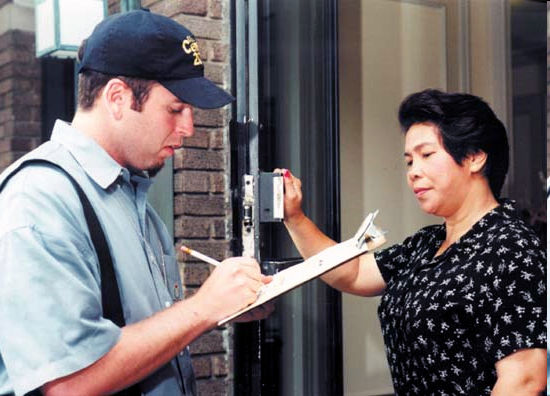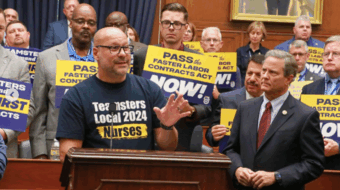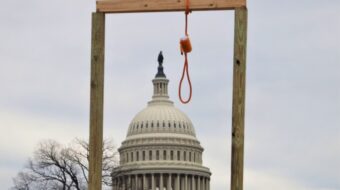
The Obama administration launched an unprecedented $340 million promotional blitz for the 2010 Census Monday with the debut of the Census Portrait of America Road Tour in New York City’s Times Square.
The tour includes a 46-foot trailer and 12 smaller cargo vans with 14-foot trailers that will crisscross more than 150,000 miles nationwide through April to promote the importance of getting people to respond to the 10-question Census.
The caravan plans to visit more than 800 events including parades and festivals such as New Orleans Mardi Gras and San Francisco’s Chinese New Year celebration. National sporting events such as the Super Bowl, the Daytona 500 and the NCAA Final Four are included.
The promotional blitz will also feature:
– $140 million for TV, radio, print and outdoor advertising, including $2.5 million for two ads in the Feb. 7 Super Bowl pregame show and a 30-second spot during the game.
– Roughly $80 million for ads directed at racial and ethnic groups and non-English speakers, in 28 languages. The bulk of it will reach out to Latinos, African Americans, Asians and American Indians. Some ads will also be in Arabic, Yiddish and other languages.
This year the government is making an extra effort to count those who have traditionally been hard to count: racial and ethnic minorities, immigrants and the poor.
Leading civil rights groups such as the NAACP Legal Defense Fund, the National Council of La Raza, the National Urban League and the National Coalition of Black Civic Participation have joined together to promote the Census in a national campaign called Count on Change 2010.
The 2000 Census overlooked 1 million people of color, including more than 600,000 African Americans, civil rights leaders say. The distribution of federal funds to state, county and municipal governments and the distribution of political power at every level of government depend on the Census, they add.
Count on Change 2010 aims to increase the final Census response rate by 10 percent, resulting in an additional $633,000,000 in federal and state funding to hard-to-count areas in the Black and Latino communities.
Civil rights leaders want to make sure the 2010 Census does not undercount the segments of Black and Latino communities that were missed in 2000 – the poor, the mobile, and children. And new groups are now at risk of exclusion, including those disproportionately impacted by the mortgage foreclosure crisis and the hundreds of thousands displaced by Hurricanes Katrina and Rita, they point out.
Marc Morial, president and CEO of the National Urban League, said the government’s over $300 million blitz aimed at getting “hard-to-count” groups to respond to the census may not be enough.
Morial and Benjamin Jealous, president of the NAACP, are also urging the government to count prison inmates from their hometowns, not where they are incarcerated. Morial notes that with nearly 1.5 million African Americans in prison out of a total Black population of about 40 million, there is a built-in “undercount.”
The Obama administration and civil rights leaders are encouraging every household to participate in the census-taking process so that disenfranchised communities can be empowered in the coming period.
Fearing that millions of undocumented Latino immigrants may not be counted, Latino leaders are mobilizing a nationwide drive to urge the Latino community to participate.
Nearly 1 million Latinos were undercounted in the 2000 Census, civil rights leaders contend. Not only does an inaccurate census affect the distribution of federal dollars, it also impacts the drawing of congressional districts, they note. They add if undocumented immigrants, an estimated 8 million of whom are Latino, are not included, the undercount could be much greater.
According to a recent study by NDN, a Democratic advocacy group, and America’s Voice, an immigrant advocacy group, congressional delegations in eight states with large Latino populations could grow if all Latinos – the nation’s largest minority sector at some 47 million – are counted.
Six states that would gain a congressional seat include Florida, Georgia, Nevada, Oregon, South Carolina and Utah. Arizona would get two and Texas up to four.
However obstacles to counting undocumented immigrants who may be reluctant to provide their names, birthdates and phone numbers are looming especially since the 2010 Census comes three years into an immigration crackdown started by President George W. Bush. The raids and deportations continue, though less visibly, under President Obama, critics charge.
Last month, the Senate rejected a measure by Sen. David Vitter, R-La., that would have included only U.S. citizens in the official tally. The Constitution calls for all residents to be counted.
Latino leaders hope to attract full participation in the Census as a continuation of the immigrant rights activism that swept the nation beginning in 2006, when millions of Latinos and supporters marched for immigrant rights nationwide. The actions led to nationwide campaigns to naturalize immigrants followed by a mass voter registration drive.
“We want to tap into that same spirit,” said Arturo Vargas, executive director of the National Association of Latino Elected and Appointed Officials Educational Fund, a bipartisan group and census drive organizer.
Speaking to the New York Times Vargas added, “We have to go back to everybody and say, ‘Just as you marched, just as you naturalized, just as you voted, now you have to be counted.'”
Nearly 12 million Latinos voted in November 2008, an increase of 2 million over 2004, according to NDN.
Latinos as well as African American and other minority groups hope to extend their voting power with a Census count that increases more electoral representation in their communities.
They also want the Census Bureau to recruit more people of color as managers and employees so that those that are familiar with such communities are the ones calling the shots.
The 2010 Census, with state and local data on age, race and ethnicity, household size and composition, helps communities with projections for school enrollment, housing, transportation and health care. Information from the Census is used to prepare for emergency services, research and changes and to advocate for various causes.
Billions of dollars are at stake every year, in federal funds that go to states and localities to build schools, hospitals, highways and fund programs such as Medicaid.
Filling out a census form is mandatory by law.
Univision, Telemundo, Google and Best Buy have joined the effort to promote the Census.
Photo: www.mn2010census.org/employment.html









